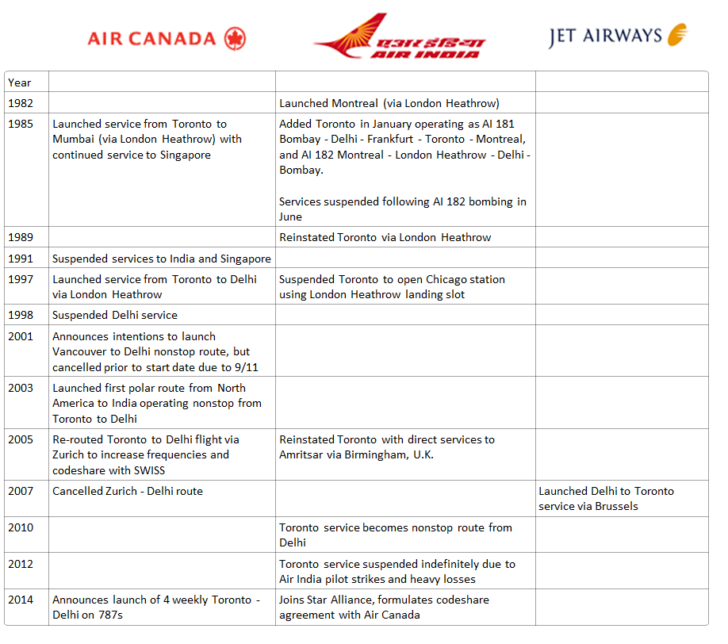Advent of fuel-efficient aircraft and alliance benefits enables re-launch of YYZ-DEL
Air Canada announced on 04-December-2014 that it will resume nonstop services between its Toronto Pearson hub and New Delhi, India, effective November 2015. The route resumption, rumored for some time by Air Canada, occurs nearly a decade after the carrier pulled the plug on its nonstop Toronto to India services following a string of political, operational and financial difficulties that made the 7,246 nm route unviable.
The Canadian flag carrier launched the first polar route from North America to India in October 2003, pioneering a new chapter in commercial aviation and hoping to reap the benefits of increased access to Russian airspace. This would enable airlines to fly over traditional 1-stop hubs in Europe such as London, Frankfurt, Paris and Amsterdam. Russia had relaxed restrictions in the early 2000’s that would permit carriers and passengers to save hours of time by forgoing a transit in Europe or Asia.
Delhi will be among the first “new” Air Canada stations to receive the Boeing 787-900 series aircraft when the route comes online November 1, 2015. The carrier intends to commence the route with a 4-weekly service, utilizing a 787-900 on 3 of the 4 days and a 787-800 on the remaining day. This is a more conservative approach than its last trial in India, when nonstop services commenced on a daily basis, although arguably also during a peak travel period to India that extended to include traffic for the Indian traditional festival of Diwali, celebrated in late October/early November.
AC050 YYZ2055 – 2115+1DEL 788 1
AC050 YYZ2055 – 2115+1DEL 789 357
AC051 DEL0045 – 0500YYZ 788 3
AC051 DEL0045 – 0500YYZ 789 25
The deployment of a 787 Dreamliner on the Delhi route will also bode well for Air Canada’s stated intentions to utilize the Dreamliner to expand and diversify its network, which has actually not materialized as rapidly as predicted given that the carrier has used its first wave of 787 deliveries to replace aircraft used on existing routes, such as Toronto to Copenhagen and Vancouver to Shanghai.
Canada – India is a massive market, yet flooded with 1-stop competition
According to the 2011 National Household Survey, approximately 1,260,000 Canadian residents claim Indian descent, with the largest communities residing in Ontario, British Columbia and Alberta. The Greater Toronto Area (GTA) is home to nearly half of them, followed next by Vancouver.
Though travel patterns between the two nations tend to be large, premium traffic tends to be on the lower end and the vast majority of the traffic is price-elastic, and therefore lower-yielding. This has created challenges for both Air Canada and Air India in the past to serve India and Canada, respectively, on their own metal instead of codesharing with partner carriers in Europe and Asia.
Prior to the advent of polar routings, both Air Canada and Air India attempted to utilize 5th-freedom services, primarily over hubs such as London Heathrow and Frankfurt, to operate 1-stop Canada-India flights. However, scissor hub operations often prove to be costly and unprofitable, and the formulation of joint venture agreements and strategic business alliances in the late 1990’s proved to be more favorable alternatives for filling the void.
Air India integration into Star Alliance should have a net positive effect on the route
Government-owned Indian flag carrier Air India concluded its final chapter of integration into Star Alliance in July 2014, following a painful seven-year implementation process that miraculously ended on a cordial note. Both Air India and Air Canada launched a formal codeshare agreement in October 2014, which likely served as a precursor to Air Canada’s resumption of Indian services. Air Canada was a founding member of Star Alliance in 1997.
Currently, Air Canada places its code on Air India-operated flights from Delhi to Amritsar, Bangalore, Chennai, Hyderabad and Kolkata, as well as from Mumbai to Bangalore, Chennai, Hyderabad and Kolkata. Air India places its code on several Air Canada-operated flights from London Heathrow to Toronto, Vancouver, Calgary, Edmonton, Halifax and St. John’s, as well as Paris to Toronto and Montreal and Vancouver to Hong Kong and Shanghai.
Noticeably, Air Canada’s transatlantic services from Frankfurt to Calgary, Toronto and Montreal were excluded from the agreement, along with Lufthansa services from its Frankfurt and Munich hubs to Delhi, Mumbai, Toronto, Vancouver and Montreal, indicating that relations with Lufthansa, ironically its original sponsor into Star Alliance, are likely still in the cooling phase. Tension between Air India and Lufthansa have escalated in recent years after AI failed to meet its integration deadline in 2011 to join Star.
Related: Spurned by Star Alliance, Air India edges towards OneWorld
While Air India operates its largest hub/base at Delhi Indira Gandhi International airport, the current schedule for Air Canada’s late evening arrival into Delhi do not facilitate a wide array of connection opportunities to domestic Indian markets on the outbound flight. Current schedule data in OAG show that only Amritsar and Mumbai have late evening flights departing Delhi on Air India. Returning from India, however, Air India offers a late evening bank of arrivals from domestic markets all over South Asia that will time well with the post-midnight departure to Toronto.
Both Air India and Air Canada have failed, multiple times, in serving the Canada – India market
Despite the sheer size of the Canada – India market, both Canadian and Indian flag carriers have had a checkered history in serving both markets successfully. The only carrier that has consistently maintained service through the years is Jet Airways, which operates a scissor-hub operation via Brussels between Toronto and New Delhi.
Research indicates that both Air India and Air Canada have histories of serving the Canada – India market dating back to the early 1980s, and subsequently encountering multiple stumbling blocks throughout the decades.
Air India’s reputation in Canada has been crippled from the AI 182 bombing incident
Air India has suffered from a legacy of negative perceptions among the Indian diaspora in Canada following the 1985 crash of Air India flight 182 off the coast of Ireland. The disaster was eventually traced to a bomb explosion in the luggage hold of the aircraft, then flying from Montreal to Delhi (via London Heathrow) as an act of terrorism committed by a Sikh militant group in Vancouver, and tragically resulted in over 300 civilian deaths.
Since that period, Air India has had a dashed history of serving the Canadian market successfully, and has largely defaulted to primarily catering the Punjabi/Sikh community in Ontario. In one attempt, Air India offered a direct flight from Toronto to Amritsar on its new 777-200LRs via Birmingham, U.K. in each direction, before eventually moving the stoppover to London Heathrow and originating the flight from Delhi.
When Air India received its 777-300ERs, the carrier created a nonstop service between Delhi and Toronto, with the intention of being the leading carrier offering nonstops from North America to India (Air India currently flies nonstop from Chicago to Delhi, New York JFK to Delhi and Newark to Mumbai). After the massive pilot strikes in 2012, Air India suspended its Toronto services and has not attempted to restart them, which is unsurprising given that its other three ultra long-haul routes to Newark, Chicago and New York JFK are highly loss-making for the carrier.
Air Canada’s network strategy in India has largely failed due to sub-optimal planning
Air Canada, by far a stronger carrier financially than the state-supported Air India, has still not been exempt from the challenges of viably serving the Canada – India market nonstop. Theoretically, Air Canada should have been the forerunner in establishing itself as the premier 1-stop carrier to fly from North America to India when the polar route became available to it in the early 2000s, but stalled due to lack of aggression and macroeconomic forces. Air Canada had actually intended to launch nonstop service to India as early as Fall 2001, but cancelled its proposed startup between Vancouver and Delhi in wake of the September 2001 terrorist attacks and global economic downturn.
Air Canada subsequently chose to launch the nonstop route from Toronto several years later in order to facilitate more connections throughout Canada and the U.S. as Person International is its largest hub. The route proved to be popular among passengers from both U.S. and Canadian points of sale and saved hours of transit time for customers.
However, poor oversight led to challenges a mere few weeks after startup due to political strife with Russian overflight authorities. Shortly after the route began in October 2003, Canada lost its authorities to enter into Russian aerospace (allegedly, Air Canada’s new Delhi-Toronto flight was siphoning a detrimentally large number of transit passengers who had been using Aeroflot’s 1-stop service via Moscow between Toronto and Delhi).
With these restrictions in place, Air Canada had to schedule a technical fuel stop in Stockholm on the westbound return from Delhi to Toronto, where it faced greater headwinds, thus inconveniencing passengers with an extra stoppover that added additional transit time. Air Canada also had to bump passengers and luggage on the eastbound sector from Toronto in order to carry additional fuel to avoid Russian aerospace. Overall, the situation was unfavorable and a PR nightmare for Air Canada.
Although the misfortunes were eventually reversed and the nonstop was restored, Air Canada chose to trade in the nonstop for a 1-stop connection via Zurich, down-gauging the aircraft from an Airbus A340 to a Boeing 767, although touting an increase in frequency from 3 weekly to daily. However, customers now had less incentive to choose Air Canada over the plethora of pre-existing 1-stop services on European, Asian and more recently, U.S. carriers such as Continental (now United) and American (since terminated) that flew nonstop to India from Newark and Chicago.
Histories of Canadian and Indian carriers in each market
Related post: The world’s longest flights (part one)
The 787 will not be a panacea for Air Canada’s India flights, but costs will be lower and alliance ties will help
The primary challenge that lies ahead for Air Canada is to avoid making the same mistakes as it has in the past to allow its India services to survive over the long run.
Canada has a long history of over-protectionism when it comes to the flag carrier, and that has led to years of protesting against lower-cost incumbent carriers seeking to siphon traffic away from Air Canada and its Star Alliance immunized joint venture partners to countries in the South Asia region. Emirates, Etihad and Qatar Airways, most notably, have been restricted to 3 weekly flights each to Canada from their home bases in Dubai, Abu Dhabi and Doha, respectively. The major selling point for the three Gulf Coast carriers is their network access to smaller markets in the subcontinent that eliminate the need to transit in a larger city such as Delhi, Mumbai or Hyderabad.
Among the Indo-Canadians in the GTA, for example, the Middle East carriers are favorable options given that the diaspora is spread among various regions in the subcontinent, primarily representing individuals with Punjabi, Bengali, Malayalee, Guarati, Marathi, Tamil and Goan roots. The opposite scenario is true in Vancouver, where the vast majority tend to hail from the State of Punjab to the north. Moreover, without a Middle Eastern carrier present in Western Canada, Air Canada would likely be successful in operating a Vancouver to Delhi nonstop.
Nevertheless, the sheer size of the Indian community in Toronto relative to other Canadian markets still justifies the logic for choosing Pearson airport over Vancouver. The limitations with onward connecting traffic from Delhi, however, will need to be resolved in order to support transit passengers without significant layover periods.
Furthermore, Air Canada has greater flexibility with its long-haul fleet in 2015 than it did in 2005 when it was forced to pull the Airbus A340 off the Toronto to Delhi nonstop in order to maintain service to its other longhaul markets. The deliveries of more Boeing 777s and 787s have curbed that issue for the time being.
If all comes to fruition, Air Canada may have finally discovered the right formula for linking its home country and the subcontinent. Should the Delhi flight prove successful, this could pave way for an eventual nonstop to Mumbai, with the Air India codeshare already in place, and perhaps creating a favorable scenario for Delhi – Toronto and Mumbai – Toronto on alternating dates.





